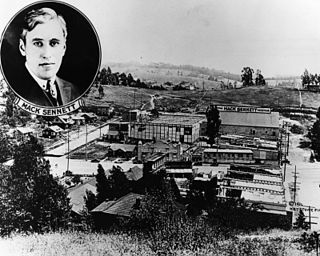
Keystone Studios was an early film studio founded in Edendale, California on July 4, 1912 as the Keystone Pictures Studio by Mack Sennett with backing from actor-writer Adam Kessel (1866–1946) and Charles O. Baumann (1874–1931), owners of the New York Motion Picture Company. The company, referred to at its office as The Keystone Film Company, filmed in and around Glendale and Silver Lake, Los Angeles for several years, and its films were distributed by the Mutual Film Corporation between 1912 and 1915. The Keystone film brand declined rapidly after Sennett went independent in 1917.

Grace Cunard was an American actress, screenwriter and film director. During the silent era, she starred in over 100 films, wrote or co-wrote at least 44 of those productions, and directed no fewer than eight of them. In addition, she edited many of her films, including some of the shorts, serials, and features she developed in collaboration with Francis Ford. Her younger sister, Mina Cunard, was also a film actress.
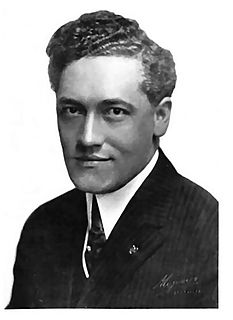
Fred J. Balshofer was a pioneering silent film director, producer, screenwriter, and cinematographer in the United States.
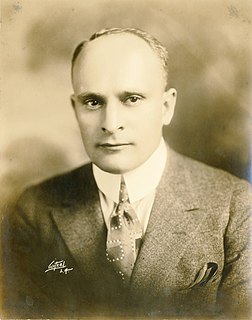
Charles Gardner Sullivan was an American screenwriter and film producer. He was a prolific writer with more than 350 films among his credits. In 1924, the magazine Story World selected him on a list of the ten individuals who had contributed the most to the advancement of the motion picture industry from its inception forward. Four of Sullivan's films, The Italian (1915), Civilization (1916), Hell's Hinges (1916), and All Quiet on the Western Front (1930), have been listed in the National Film Registry.

Charles O. Baumann was an American film producer, film studio executive, and pioneer in the motion picture industry.
The New York Motion Picture Company was a film production and distribution company from 1909 until 1914. It changed names to New York Picture Corporation in 1912. It released films through several different brand names, including 101 Bison, Kay-Bee, Broncho, Domino, Reliance, and Keystone Studios.
Hal Clements was an actor and director of silent films in the U.S. He starred in dozens of silent films. He married writer Olga Printzlau.
Adam Kessel, Jr. (1866–1946) was a film company executive. He partnered with Charles Baumann in a series of film distribution and production companies.

Astra Film Corp was an American film production company that produced silent films. Louis J. Gasnier was the company's president. George B. Seitz co-founded it. It was making films by 1916. It became Louis J. Gasnier Productions after Seitz left.
The Dawson Film Find (DFF) was the accidental discovery in 1978 of 372 film titles preserved in 533 reels of silent-era nitrate films in the Klondike Gold Rush town of Dawson City. The reels had been buried under an abandoned hockey rink in 1929 and included lost films of feature movies and newsreels. A construction excavation inadvertently uncovered the forgotten cache of discarded films, which were unintentionally preserved by the permafrost.
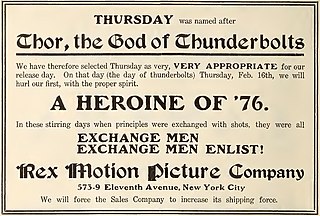
Rex Motion Picture Company was an early film production company in the United States.
John Gerald Hawks was an American screenwriter. He wrote several scripts for Thomas H. Ince's Kay-Bee Pictures. His career ended with the transition to talking pictures requiring scripted dialogue.

Edwin Middleton (1865–1929) was a film director in the United States.

Albert W. Hale was a French-born American early film director and producer. He directed some 35 films from 1912 until 1915. He worked for Majestic Studio, and the National Film Corporation.
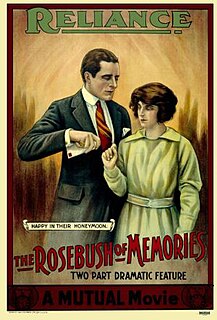
Reliance Film Company was an early movie studio in the United States. It was established in 1909 and was bought out a couple years later from Charles O. Baumann, Adam Kessel, and Charlie Kessel

Violet Horner was an American silent film actress. She had several starring roles including in one of the Lena Rivers films released in 1914 and a series of films made with Billy Quirk for Gem Motion Picture Company including Billy's Adventure.

William Robert Daly was an actor and director of silent films in the U.S.
Pallas Pictures was a film studio in the U.S. headed by Frank A. Garbutt. In 1913 the film production company Bosworth Incorporated was founded to release film adaptations of Jack London's stories. Hobart Bosworth was President of the company but as Jack London wrote, "Mr. Garbutt has absolute charge of the entire business of Bosworth, Inc." The company rented studio space until September 1914 when Bosworth Inc. constructed its own studio at 211 N. Occidental Blvd., Los Angeles. When Hobart Bosworth left in 1915 Garbutt assumed full control of Bosworth Inc. Several months later the company was renamed Pallas Pictures, with Melodile Garbutt listed as president of Pallas Pictures. The Pallas logo was a capital "P" with an owl on a branch.
William Frederick Jury was an influential film businessman in Britain. He led Jury Imperial Pictures, a British film production company during the silent film era. It was a leading renter of films and contracted to distribute official British films. It was also distributor of American films and was active in British colonies. Jury was also involved in distributing propaganda films for the British government.
William Canfield was an actor on stage and screen known for portraying villains. He was in the 1915 serial The Broken Coin and the 1918 war propaganda film Why America Will Win.













